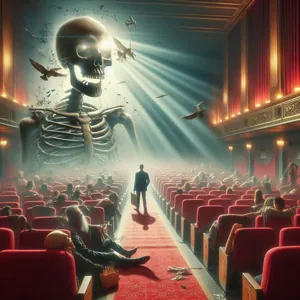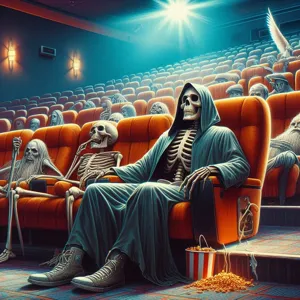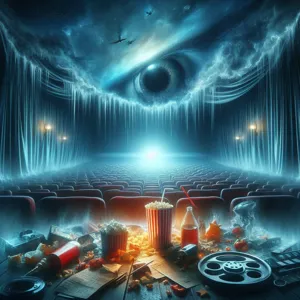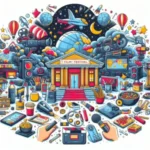As the golden age of cinema gives way to an increasingly digital landscape, the future of film is a topic sparking intense debate among filmmakers, industry insiders, and moviegoers alike.
With the rise of streaming platforms, home theaters, and on-demand content, the traditional movie theater experience faces unprecedented challenges that could forever alter how we consume films. Is the grand cinematic adventure destined to become a relic of the past, or can it evolve to coexist with emerging technologies? In this blog post, we delve into the shifting dynamics of the film industry, examining the impact of technological advancements, changing audience behaviors, and the potential for innovation that may redefine the essence of movie-watching. Join us as we explore the question that looms large over Hollywood: Is the death of the movie theater imminent, or will it find a way to thrive in this brave new world?
1. Introduction: The Changing Landscape of Cinema

The landscape of cinema is undergoing a seismic shift, one that has been both exhilarating and alarming for film enthusiasts and industry professionals alike. As streaming services continue to dominate the entertainment market, viewers are increasingly opting for the convenience of watching films from the comfort of their own homes. The rise of platforms like Netflix, Hulu, and Disney+ has revolutionized how audiences consume content, providing unprecedented access to a vast array of films and series at their fingertips.
This evolution has sparked a crucial conversation about the future of traditional movie theaters. Once regarded as cultural landmarks and communal spaces for shared cinematic experiences, theaters are now grappling with dwindling attendance and escalating operational costs. The pandemic further accelerated this trend, with many theaters forced to close temporarily or permanently, raising concerns about their sustainability in an ever-evolving digital age.
However, while streaming has undoubtedly transformed viewing habits, it has also sparked a resurgence of interest in the theatrical experience for certain segments of the audience. The thrill of watching a film on the big screen, the immersive sound systems, and the communal atmosphere of shared laughter, gasps, and tears are experiences that streaming alone cannot replicate. This duality presents a complex narrative: while the movie theater’s role is being challenged, it is not necessarily doomed.
In this exploration of cinema’s future, we will delve into current trends, technological advancements, and shifting consumer preferences that are reshaping the industry. Are we witnessing the gradual decline of movie theaters, or is there potential for a renaissance? Join us as we navigate this fascinating terrain, examining the factors at play and the possibilities that lie ahead for both filmmakers and audiences alike.
2. The Rise of Streaming Services: A Game Changer
The rise of streaming services has undeniably transformed the landscape of film consumption, marking a significant shift in how audiences engage with movies. Gone are the days when a trip to the cinema was the primary means of enjoying a new release. Instead, platforms like Netflix, Hulu, Amazon Prime Video, and Disney+ have made it possible for viewers to access a vast library of films from the comfort of their own homes. This convenience is a game changer, allowing audiences to watch on their own schedules without the constraints of showtimes or the need to brave traffic and long lines.
Streaming services have not only democratized access to films but also diversified the types of content being produced. original movies and series have flooded these platforms, offering fresh perspectives and innovative storytelling that might not have found a place in traditional theaters. The success of films produced specifically for streaming—like “Roma” and “The Irishman”—has challenged the long-held belief that cinematic quality is synonymous with a theater release.
Moreover, the global reach of streaming platforms means that audiences can discover international films that may have otherwise gone unnoticed. With just a few clicks, viewers can explore diverse cultures and narratives, broadening their cinematic horizons. This shift has nurtured a more inclusive film landscape, where niche genres and independent films can thrive away from the box office spotlight.
However, this convenience does come with its own set of challenges for movie theaters. As audiences grow accustomed to the ease of streaming, the allure of the big screen diminishes. The communal experience of watching a film with a crowd—filled with laughter, gasps, and shared emotions—can feel less enticing when one can replicate a similar experience at home with a few friends and some popcorn.
As streaming services continue to evolve and dominate the market, the future of film remains uncertain. Will the traditional movie theater adapt and find ways to coexist with this new reality, or are we witnessing a slow but inevitable decline in the cinematic experience as we know it? The answer could redefine the way we view and appreciate film in the years to come.
3. Pandemic Impact: How COVID-19 Affected Movie Theaters

The COVID-19 pandemic has left an indelible mark on the film industry, serving as both a catalyst for change and a revealing mirror reflecting the vulnerabilities of traditional movie theaters. As lockdowns swept across the globe in early 2020, cinema screens went dark, silencing the flickering images and hushed gasps of audiences. For many theaters, this abrupt halt was not just a temporary setback; it exposed a fragile business model that relied heavily on crowded screenings and the popcorn-fueled excitement of shared experiences.
As theaters struggled to adapt to health guidelines and shifting consumer behavior, many were forced to close their doors permanently. The few that managed to reopen found themselves facing a daunting challenge: how to entice audiences back into the fold amidst ongoing fears of contagion. While some moviegoers eagerly returned, many others grew accustomed to the comfort of home viewing, enjoying the convenience of streaming services that delivered fresh content straight to their living rooms.
The pandemic also accelerated the evolution of distribution models. Major studios, once hesitant to release films outside of traditional theatrical windows, began experimenting with simultaneous releases on streaming platforms. The success of films released directly to digital audiences challenged the long-standing belief that big-budget blockbusters required a theatrical debut to thrive. As a result, the lines between cinema and home viewing blurred, raising questions about the very future of movie theaters.
Moreover, studios discovered new revenue streams and audience engagement strategies during this tumultuous time. Virtual premieres, interactive watch parties, and even drive-in movie experiences became essential tools for keeping the magic of cinema alive, albeit in altered forms. As a result, the pandemic has not only reshaped the landscape of film distribution but has also forced theaters to reevaluate their value proposition.
In this rapidly changing environment, movie theaters must innovate to survive. Whether through enhanced safety measures, unique viewing experiences, or by harnessing technology to offer hybrid viewing options, the industry faces a pivotal moment. The question remains: will the allure of the cinema experience be enough to draw audiences back, or has the pandemic irreversibly transformed the way we consume film? The future of movie theaters hangs in the balance, and the coming years will reveal whether they can adapt and thrive in a post-pandemic world.
4. The Evolution of Home Viewing Experiences
The evolution of home viewing experiences has dramatically transformed the way audiences consume films, creating a landscape that challenges the traditional movie theater model. Once relegated to flickering screens and modest sound systems, home entertainment has morphed into an immersive experience rivaling that of the silver screen. High-definition televisions, 4K streaming options, and surround sound systems have become staples in living rooms, making it easier than ever for movie enthusiasts to replicate the cinema experience from the comfort of their homes.
Streaming services like Netflix, Hulu, and Disney+ have revolutionized accessibility, offering vast libraries of films and original content that are just a few clicks away. No longer bound by showtimes or the need to find parking, viewers can curate their own viewing schedules, binge-watch entire series, or discover hidden gems at their leisure. The convenience factor cannot be overstated; with the ability to pause, rewind, or rewatch scenes, home viewing caters to individual preferences and enhances the overall enjoyment of a film.
Additionally, the rise of smart home technology has further enriched this experience. Voice-activated assistants allow for seamless control of viewing options, while advanced projectors and screen systems can create a mini-theater atmosphere in even the smallest of spaces. With the introduction of virtual reality and augmented reality, the boundaries of home viewing are continually being pushed, offering immersive experiences that transport viewers directly into the heart of the story.
While the allure of the theater—with its larger-than-life screens and communal atmosphere—remains undeniable, the advancements in home viewing technology pose a significant challenge to traditional cinemas. As audiences increasingly opt for the comfort and convenience of streaming at home, the future of film may very well hinge on how theaters adapt to this evolving landscape. The question remains: will they find a way to coexist with the sophisticated home viewing experiences that continue to capture the hearts of so many?
5. Box Office Trends: Analyzing Recent Data

As we dive into the evolving landscape of cinematic experiences, it’s crucial to examine box office trends that offer insight into the health of movie theaters and the film industry as a whole. Recent data reveals a complex picture, one that highlights both opportunities and challenges facing traditional cinema.
In the wake of the pandemic, many theaters faced unprecedented closures, leading to a significant decline in ticket sales. However, as restrictions lifted and audiences began to return, a gradual resurgence was observed. Blockbuster releases, particularly those from major franchises, have driven substantial box office revenues, showcasing the enduring appeal of the big-screen experience. Films like “Spider-Man: No Way Home” and “Top Gun: Maverick” generated impressive earnings, reminding us of the communal thrill that comes from sharing a cinematic moment with fellow moviegoers.
Yet, while these standout titles have reinvigorated box office numbers, the overall picture is nuanced. Independent films and mid-budget releases continue to struggle, often overshadowed by their blockbuster counterparts. This trend raises questions about the future viability of diverse storytelling in theaters. Furthermore, the rise of streaming services has altered viewing habits, with many audiences opting for the convenience and comfort of home viewing, leading to a fragmentation of the market.
Looking at demographic data, younger audiences, in particular, show a preference for streaming platforms over traditional cinema. This shift suggests that theaters may need to rethink their strategies, focusing on enhancing the in-theater experience to draw in these elusive viewers. Innovations such as luxury seating, gourmet concessions, and interactive screenings are becoming more common in an effort to create a unique atmosphere that cannot be replicated at home.
In summary, analyzing recent box office trends reveals a landscape in flux. While some blockbuster films continue to draw crowds, the overall health of the movie theater industry relies on its ability to adapt to changing consumer preferences and embrace new models of engagement. As we consider the future of film, understanding these trends will be key in determining whether the beloved movie theater experience can not only survive but thrive in the years to come.
6. The Role of Technology in Film Distribution
The landscape of film distribution is undergoing a monumental transformation, driven primarily by advances in technology. Gone are the days when audiences were limited to the big screen experience of movie theaters. Today, streaming platforms, digital downloads, and on-demand services have revolutionized how films reach their viewers, creating a more accessible and diverse cinematic landscape.
Streaming services like Netflix, Amazon Prime Video, and Disney+ have become household names, offering vast libraries of films that can be enjoyed from the comfort of one’s living room. This shift has empowered filmmakers to reach wider audiences without the constraints of traditional distribution channels. Independent films, which once struggled to find a theatrical release, can now find their footing on these platforms, allowing for a richer variety of storytelling to flourish.
Moreover, technology has made it easier for studios to analyze viewer preferences and trends. Advanced algorithms and data analytics provide insights into what audiences want to watch, enabling filmmakers to tailor their productions accordingly. This data-driven approach not only helps studios make informed decisions about which films to produce but also influences marketing strategies, ensuring that the right audience is targeted effectively.
Virtual reality (VR) and augmented reality (AR) are also beginning to carve out their place in the film distribution landscape. These technologies offer immersive experiences that go beyond traditional storytelling, creating possibilities for interactive films that engage viewers in entirely new ways. As filmmakers experiment with these mediums, audiences may find themselves drawn to experiences that blend gaming and film, blurring the lines between the two.
While the convenience of home viewing is undeniable, the cinema experience remains irreplaceable for many film enthusiasts. The communal atmosphere of a packed theater, the anticipation of a new release, and the sheer spectacle of watching on a big screen continue to hold significant appeal. However, as technology continues to evolve and reshape distribution methods, the question remains: will the traditional movie theater adapt, or will it fade into the background as streaming and digital formats take center stage? The answer may lie in how well theaters can integrate new technologies and enhance the viewing experience, ultimately determining their role in the future of film.
7. The Experience of Movie Theaters: What’s Unique?

As we grapple with the evolving landscape of film consumption, it’s essential to recognize what makes the experience of visiting a movie theater truly unique. While streaming services offer convenience and an extensive library of films at our fingertips, they cannot replicate the sensory allure and communal atmosphere that a theater provides.
Picture this: the moment you step into a cinema, you’re enveloped by the dim glow of soft lighting and the intoxicating aroma of buttery popcorn. The anticipation builds as you find your seat, adjusting the plush cushion beneath you. The massive screen looms ahead, a canvas awaiting the magic that is about to unfold. The muffled chatter of fellow moviegoers adds to the excitement, creating a palpable buzz that simply can’t be replicated at home. In a theater, you’re not just a passive viewer; you’re part of a collective experience, sharing laughs, gasps, and even tears with strangers who are equally engrossed in the story being told.
Moreover, the cinematic experience is enhanced by the technology that theaters invest in — from state-of-the-art sound systems that make each explosion feel like it’s happening right beside you, to cutting-edge projection technology that brings every detail to life with vivid clarity. The immersive nature of a theater, with its towering screens and enveloping sound, transports you into another world in a way that a living room setup rarely can.
Additionally, the ritual of going to the movies is steeped in tradition. From the pre-show previews that build excitement for upcoming films to the shared moments of silence as the lights dim and the film begins, there’s a certain magic in the process itself. Movie theaters offer a break from the everyday hustle, a chance to disconnect from our screens and immerse ourselves in a shared narrative.
While the threat of decline looms over traditional movie theaters in the wake of streaming dominance, it’s clear that the unique experience they offer — one that engages the senses, fosters community, and creates lasting memories — remains irreplaceable. As we look to the future, the challenge lies in how theaters can evolve and adapt to retain their role as cultural touchstones in an increasingly digital world.
8. Nostalgia vs. Modernity: Audience Preferences
As we navigate the ever-evolving landscape of film consumption, one of the most compelling dynamics at play is the tug-of-war between nostalgia and modernity. Audiences today are caught in a delicate balance, yearning for the comfort of cherished cinematic experiences while simultaneously embracing the convenience offered by streaming services and digital platforms.
Nostalgia plays a powerful role in cinema, evoking memories of first dates, family outings, and unforgettable moments spent in the dim glow of a theater. For many, the movie theater represents more than just a venue; it is a sanctuary where stories come to life on the big screen, enveloping viewers in a collective experience that feels almost sacred. The smell of buttery popcorn, the thrill of the opening credits, and the communal gasps and laughter from fellow audience members create a sense of camaraderie that streaming from home simply cannot replicate.
However, modernity is knocking at the door with a promise of immediacy and personalization that resonates with today’s audience. Streaming platforms provide viewers with the freedom to watch what they want, when they want, and how they want—often with just a few clicks. This convenience, paired with the rise of binge-watching culture, has transformed the way we consume films, shifting preferences toward on-demand viewing experiences that fit seamlessly into busy lifestyles.
The clash of these two forces—nostalgia for the traditional cinema experience and the allure of modern technology—presents a fascinating paradox. While theaters face challenges in attracting audiences away from their couches, they are also experimenting with innovative solutions to rekindle that nostalgic magic. Luxury seating, gourmet food options, immersive sound systems, and themed screenings are just a few tactics being employed to lure audiences back into theaters.
Ultimately, the future of film may not hinge on the extinction of the movie theater but rather on how these two opposing forces can coexist and evolve. As filmmakers and cinema owners adapt to changing preferences, striking a balance between the cherished traditions of the past and the conveniences of the present will be crucial in determining whether the movie theater remains a beloved cultural staple or fades into the background of an increasingly digital world.
9. Are Movie Theaters Adapting or Struggling?
As the landscape of entertainment continues to evolve at a rapid pace, the question looms: are movie theaters adapting to the changing demands of audiences, or are they struggling to keep up? The answer is complex and multifaceted, reflecting a mix of innovation and challenge.
On one hand, many theaters are embracing new technologies and experiences to draw audiences back. The rise of luxurious seating, gourmet concessions, and immersive sound systems has transformed the traditional movie-going experience into something more akin to an event. Premium formats like IMAX and 4DX offer viewers a chance to engage with films in ways that home viewing simply cannot replicate. Theaters are also experimenting with alternative content, such as live broadcasts of concerts, sports events, and theater performances, broadening their appeal and diversifying their offerings.
However, these adaptations come with significant hurdles. The financial pressure on theaters is immense, especially as streaming platforms continue to gain traction. With the convenience of watching movies from the comfort of home, complete with the ability to pause, rewind, and skip, cinemas face a fierce competition that’s hard to counter. Additionally, the pandemic has accelerated changes in consumer behavior, leading many to rethink the necessity of the theater experience altogether.
Moreover, the question of accessibility cannot be ignored. While some theaters have made strides in creating more inclusive environments, there remains a gap in affordability and availability for certain demographics, which can limit their audience reach.
As we look to the future, the fate of movie theaters may hinge on their ability to not only adapt but also to cultivate a unique and compelling experience that simply cannot be replicated at home. The ongoing evolution will determine whether these cherished cultural hubs will thrive or fade into the background of an increasingly digital age. The coming years will be crucial in answering whether movie theaters are indeed adapting with resilience or struggling to find their place in a world that is changing faster than ever before.
10. The Future of Film Festivals in a Digital Age
As the film industry continues to evolve in the wake of rapid technological advancements, the role of film festivals is undergoing a transformation that reflects the changing landscape of cinema consumption. In the digital age, where streaming platforms reign supreme and audiences crave instant access to content, the future of film festivals is both exciting and uncertain.
Traditionally, film festivals have served as prestigious platforms for filmmakers to showcase their work, connect with industry insiders, and engage with enthusiastic audiences. However, the rise of digital distribution has introduced new dynamics. Online film festivals have emerged, allowing filmmakers from diverse backgrounds to share their stories with global audiences without the constraints of physical venues. This democratization of access enables marginalized voices to be heard and celebrated, challenging the gatekeeping that often characterizes traditional festivals.
Despite the allure of digital formats, in-person festivals still hold significant value. They provide a unique opportunity for filmmakers and audiences to engage in meaningful conversations, foster connections, and create a sense of community. Events like Sundance, Cannes, and Tribeca continue to draw significant crowds, offering an immersive experience that transcends the digital realm. The atmosphere of shared excitement, the thrill of premieres, and the personal interactions cannot be wholly replicated online.
The future may lie in a hybrid model, blending the best of both worlds. Festivals can expand their reach by offering virtual screenings alongside traditional in-person events, allowing audiences who may not have the means or ability to travel to participate. This approach can enhance accessibility and introduce fresh perspectives, ultimately enriching the festival experience.
Moreover, as the industry grapples with environmental concerns, the digital shift presents an opportunity for more sustainable practices. Reducing the carbon footprint associated with travel and venue logistics can align festivals with growing consumer demand for eco-conscious initiatives.
In summary, the future of film festivals in a digital age is poised for innovation and adaptation. By embracing technology while preserving the communal spirit that defines the festival experience, filmmakers and audiences can continue to celebrate the art of cinema in ways that are both inclusive and impactful. The challenge will be to strike the right balance as we navigate this new terrain, ensuring that the magic of film festival culture is not lost but rather transformed for a new generation of cinephiles.
11. The Importance of Community and Shared Experiences
As we navigate the evolving landscape of film consumption, one aspect that remains irreplaceable is the sense of community and shared experiences that movie theaters provide. The collective energy of an audience, the collective gasps, laughter, and even silence in moments of suspense create a unique atmosphere that cannot be replicated in the confines of our living rooms.
When you step into a darkened theater, you’re not just watching a film; you’re participating in a communal ritual that dates back to the dawn of cinema. The anticipation builds as the lights dim, and the sheer presence of others around you amplifies the emotional highs and lows of the story unfolding on screen. This shared experience fosters connections—between friends, families, and even strangers who find themselves united in their reactions to a gripping plot twist or a heartwarming moment.
In an age of streaming services that allow for solitary viewing experiences on any device, the importance of community cannot be overstated. Movie theaters are more than just venues; they are social hubs where people come together, share their thoughts, and engage in discussions about the films they’ve just experienced. They provide a space for film enthusiasts to connect through events like film festivals, midnight screenings, and Q&A sessions with filmmakers, creating a vibrant culture around cinema that streaming platforms often lack.
Moreover, the rise of local theaters and independent cinema showcases the power of community-driven initiatives. These establishments not only screen films but also curate experiences that highlight local talent, host themed nights, and foster discussions that enrich the cinematic experience. As we consider the future of film, it’s crucial to recognize that while technology continues to reshape how we access content, the desire for shared experiences and community remains a driving force behind our love for cinema. The movie theater, with its ability to bring people together, may very well continue to thrive in this digital age, standing as a testament to the enduring power of storytelling in a communal setting.
12. Innovations in Theatrical Experience: IMAX, 4D, and Beyond
As the landscape of cinema continues to evolve, theaters are not simply folding under the pressure of streaming services; instead, they are innovating and transforming the viewing experience to keep audiences engaged. Innovations such as IMAX and 4D technology are at the forefront of this evolution, offering experiences that can’t be replicated at home.
IMAX, with its colossal screens and immersive sound systems, transports viewers into the heart of the action. This format enhances not just the size of the film but the entire sensory experience, making even the most mundane scenes feel epic. Audiences find themselves surrounded by larger-than-life images that dominate their field of vision, coupled with crystal-clear audio that brings every whisper, footstep, and explosion to life. This heightened reality is a significant draw for those who crave a unique cinematic adventure.
Moving beyond IMAX, 4D cinema takes immersion to another level. Picture this: as you watch a thrilling car chase unfold on screen, you feel the seat rumble beneath you, wind blowing through your hair, and even the scent of burning rubber wafting through the air. Incorporating environmental effects like motion, scent, and even temperature changes, 4D theaters create a multisensory experience that captivates audiences and makes them an active participant in the film. It’s an exhilarating ride that simply cannot be replicated in the comfort of your living room.
Beyond IMAX and 4D, theaters are exploring other innovative features to enhance the viewing experience. Luxury seating, gourmet dining options, and personalized service are becoming more commonplace, catering to a demographic that desires more than just a movie; they crave an event. The addition of interactive elements, such as audience participation or augmented reality experiences, is also beginning to emerge, blurring the lines between viewer and performer.
As these innovations take shape, the movie theater is being redefined as a destination rather than just a venue. Theaters are adapting to meet the changing preferences of consumers, transforming into social hubs where friends and families gather not only to watch a film but to enjoy an experience that is memorable and unique. In this way, the death of the traditional movie theater seems less imminent; instead, it may be on the brink of a remarkable renaissance, fueled by creativity and technology.
In a world where the allure of streaming is undeniable, the power of innovation in the theatrical experience could very well ensure that the big screen remains an integral part of our cultural fabric for years to come.
13. The Role of Independent and Art House Theaters
In an era dominated by streaming giants and blockbuster franchises, the role of independent and art house theaters has become increasingly vital. These smaller, often family-owned cinemas serve as the last bastion for niche films, foreign cinema, and groundbreaking independent productions that might otherwise struggle for visibility in a crowded marketplace. Unlike mainstream theaters that primarily showcase big-budget films, independent theaters curate a unique selection of films, often prioritizing quality storytelling and artistic vision over commercial viability.
These venues are not just places to watch films; they are cultural hubs that foster community engagement and provide a space for discussion and discovery. Regular screenings of classic films, themed series, and film festivals create a vibrant atmosphere that invites moviegoers to explore diverse genres and perspectives. Many art house theaters also host Q&A sessions with filmmakers, offering audiences an intimate glimpse into the creative process behind the films they love.
Moreover, independent theaters often prioritize the experience of the audience. With cozy seating, local art on the walls, and the smell of freshly popped popcorn wafting through the air, these venues create a sense of nostalgia and charm that is often missing in large chains. The personal touch extends to their programming, with many theaters showcasing local talent and offering community events that strengthen their ties to the neighborhoods they serve.
As streaming services continue to rise, the challenge for independent and art house theaters lies in adapting to changing consumer habits while maintaining their unique identity. They must find ways to enhance the cinematic experience, perhaps by offering special events, themed nights, or exclusive screenings that can’t be replicated at home. The survival of these theaters may depend on their ability to innovate and connect with an audience that craves not just entertainment, but a shared experience that transcends the confines of a living room.
In conclusion, the future of film may be uncertain, but independent and art house theaters have a crucial role to play in preserving the richness and diversity of cinematic storytelling. As long as they continue to champion artistic expression and foster community engagement, these theaters will remain a vital part of the film landscape, offering audiences an escape into the extraordinary world of cinema.
14. Predictions: What’s Next for the Film Industry?
As we peer into the crystal ball of the film industry, several intriguing predictions emerge about its trajectory in the coming years. The convergence of technology, shifting consumer preferences, and the aftermath of global events are poised to reshape how we experience storytelling on screen.
One of the most significant trends is the continued rise of streaming platforms. As services like Netflix, Disney+, and Amazon Prime Video invest heavily in original content, we can expect an even broader array of films to be produced, often tailored to niche audiences. This democratization of filmmaking allows diverse voices to emerge, giving rise to innovative narratives that may have been overlooked by traditional studios. However, this shift also raises questions about the sustainability of such a model and whether it can continue to thrive amidst increasing competition.
Moreover, advancements in virtual and augmented reality are set to revolutionize the cinematic experience. Imagine not just watching a film, but being fully immersed in it—interacting with characters and environments in ways previously confined to the realm of video games. This interactivity could redefine what it means to be a viewer, transforming passive consumption into active participation.
On the other hand, the allure of the big screen will likely endure, albeit in an evolved form. The communal experience of watching a film with an audience brings an unparalleled energy that cannot be replicated at home. As a result, movie theaters may pivot to offer more personalized experiences, such as premium screenings, immersive sound systems, and luxurious seating arrangements. Theaters could also become event spaces, hosting film festivals, director Q&As, or themed screenings that cater to passionate fan bases.
Lastly, the film industry may see a renewed focus on sustainability. As awareness of environmental issues grows, filmmakers and studios will increasingly consider the ecological impact of production processes. This could lead to innovative practices in filmmaking, distribution, and even theater operations, as the industry seeks to balance creativity with responsibility.
In summary, the future of film is poised to be a dynamic blend of traditional and modern approaches, driven by technology, audience engagement, and a commitment to sustainability. While the movie theater is at a crossroads, it is far from doomed. Instead, it might just be on the brink of a transformative evolution that could redefine the way we connect with stories for generations to come.
15. Conclusion: Can Movie Theaters Survive the Evolution of Film?
As we stand at the crossroads of cinematic evolution, the question looms large: Can movie theaters survive in an age dominated by streaming services, advanced home technology, and ever-shifting consumer preferences? The heart of the movie-going experience has always been the communal aspect—the thrill of sharing laughter, gasps, and tears with a crowd. Yet, as convenience becomes king, the allure of watching the latest blockbuster from the comfort of one’s couch grows increasingly tempting.
However, this is not the end for theaters. In fact, many are innovating and adapting to maintain their relevance in a rapidly changing landscape. Enhanced viewing experiences, such as IMAX screenings, luxurious seating, and gourmet concessions, are enticing audiences back to the big screen. Special events, such as live broadcasts of concerts or sporting events, and themed movie nights are also drawing in diverse crowds, providing unique experiences that home viewing cannot replicate.
Moreover, the rise of independent films and niche genres is creating a new segment of the audience eager for theatrical experiences that are often overlooked by mainstream platforms. Film festivals and art houses are thriving, proving that there is still a robust demand for the shared experience of cinema.
Ultimately, the survival of movie theaters hinges on their ability to evolve in tandem with the industry. By embracing technology, curating unique experiences, and fostering a sense of community, theaters can carve out a sustainable future. While the landscape of film consumption may be shifting, the magic of the cinema, with its grand screens and immersive sound, may yet retain its cherished place in our cultural fabric. The journey is far from over; it’s merely entering a new chapter, one that could redefine the essence of what it means to watch a film together.
As we navigate the evolving landscape of film consumption, it’s clear that the future of cinema is both exciting and uncertain. Our exploration of the factors influencing the potential decline of movie theaters has shed light on the shifting preferences of audiences, the rise of streaming platforms, and the ongoing innovations in technology that are reshaping how we experience stories. While the traditional movie theater may face significant challenges, it’s also important to recognize the resilience of this beloved medium and its ability to adapt. Whether through unique viewing experiences, community engagement, or the simple magic of the big screen, theaters still hold a special place in our hearts. As we look to the future, let’s remain hopeful for a cinematic landscape that embraces both the vibrant energy of theaters and the convenience of digital platforms, ensuring that the art of storytelling continues to thrive in all its forms. What are your thoughts on the future of film? We’d love to hear your insights in the comments below!






